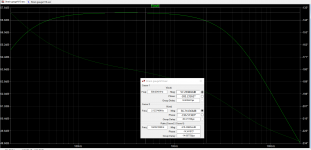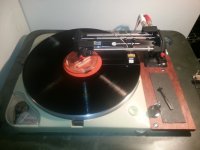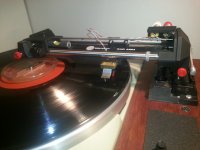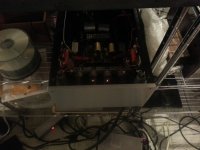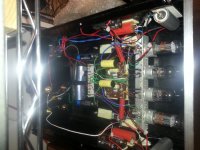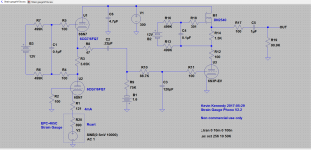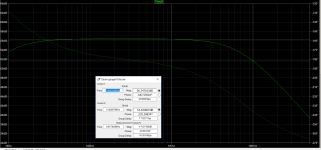I have quite a lot of measurement hardware as you might suspect, but am in the processing of scrapping the old audio measurement system, bits and pieces of it have moved on to other purposes where they are needed more. The FFT hardware is problematic at best, on a good day sfdr was about 110dB, but this was before some event (a lightning strike maybe?) wiped out half of the inputs so I no longer trust it.
I am going to an RTX-6001 and my laptop, uTracer is already updated and functional with my new laptop. Desktop elimination is the goal here.
I think this might be a good excuse for Scott to come over sometime soon regardless. A sanity check and some good FR measurements would be good. I have glide tones and pink noise on vinyl. All EQ can be defeated.
Talking of which in the next post I have some interesting developments to share.
I am going to an RTX-6001 and my laptop, uTracer is already updated and functional with my new laptop. Desktop elimination is the goal here.
I think this might be a good excuse for Scott to come over sometime soon regardless. A sanity check and some good FR measurements would be good. I have glide tones and pink noise on vinyl. All EQ can be defeated.
Talking of which in the next post I have some interesting developments to share.
A change in direction
I have iterated through several versions of EQ blindly.
I have made a number of significant changes, I eliminated the shelving HPF which provided boost to try and correct for the hole between 500Hz - 2122Hz, but I have retained a relatively drastic roll off above 1kHz, which is about -3dB at 6kHz.
The bass below 50Hz definitely needs to be rolled off, and currently it is down about 3dB at 17Hz relative to 1kHz. Some may want more than this.
I also switched to a pair of vintage RCA 6FQ7 I had sitting in my stash. Examination of the plate curves of the 6DJ8 at 4mA indicated it was not as linear as one might want, and in my circuit the division of supply voltages in the follower lead to poor performance at HF - higher voltage was not really an option unless I switched to the 6N23P which can withstand more voltage than western made 6DJ8. I was not convinced that doing so would solve all of the problems so I switched to a different tube as well as higher voltage.
This seems like a good point to encourage anyone interested to build one.
300V at approximately 30mA is required. The supplies discussed in the any of the Muscovite threads are appropriate as would be the SSHV2.
Edits:
A couple of things to note:
I have iterated through several versions of EQ blindly.
I have made a number of significant changes, I eliminated the shelving HPF which provided boost to try and correct for the hole between 500Hz - 2122Hz, but I have retained a relatively drastic roll off above 1kHz, which is about -3dB at 6kHz.
The bass below 50Hz definitely needs to be rolled off, and currently it is down about 3dB at 17Hz relative to 1kHz. Some may want more than this.
I also switched to a pair of vintage RCA 6FQ7 I had sitting in my stash. Examination of the plate curves of the 6DJ8 at 4mA indicated it was not as linear as one might want, and in my circuit the division of supply voltages in the follower lead to poor performance at HF - higher voltage was not really an option unless I switched to the 6N23P which can withstand more voltage than western made 6DJ8. I was not convinced that doing so would solve all of the problems so I switched to a different tube as well as higher voltage.
This seems like a good point to encourage anyone interested to build one.
300V at approximately 30mA is required. The supplies discussed in the any of the Muscovite threads are appropriate as would be the SSHV2.
Edits:
A couple of things to note:
- Cartridge left and right channels are phase inverted one relative to the other. I've made no effort to deal with this in the phono stage because I can select output polarity of my line stage independently. Worst case you would have to swap the polarity of one speaker. Swapping cartridge leads will not do it!
- I violated at least one of the tenets of good analog design. The first stage should have more gain than the second stage, but doesn't. Keeping the ability to drive long cables (9 feet) was the overriding design consideration so I used the circuit proven to do that effectively. SNR regardless is beyond adequate. The cartridge is likely the dominant noise source.
Attachments
It's portable too which saves me from moving 120lbs of turntable to a spot convenient for testing.
It's portable too which saves me from moving 120lbs of turntable to a spot convenient for testing.
Kevin PM me I'd love to come by and tinker (maybe help out) anything I have you are welcome to borrow. I have a couple of phono stages I'd like to compare also.
EDIT - I have the full set of CBS STR series test disks if that would help.
Last edited:
You're more than welcome and it's a great opportunity for me to learn something. I'll PM you over the next couple of days once I figure out my schedule.
Edit: I am always interested in what others are doing wrt phono stages, I've got a windfeld with SUT as a source on the other table.
Edit: I am always interested in what others are doing wrt phono stages, I've got a windfeld with SUT as a source on the other table.
I'm looking forward to a get together with Scott, he lives quite close by now, and this is overdue.. 😀
I'd be concerned the pile of round silver disc in photo #3 might be sucking out the soul of the preamp.
🙂
Alan
🙂
Alan
Touche, that must be it.. LOL
So far this is by far the best sounding iteration, perspective is a bit distant at times and I now have an idea to "improve" the EQ a bit.
I think I'll want to do some measurements with Scott's assistance in the very near future, better to have an an actual in situ target to aim at rather than a few graphs from a 40 yr old magazine article which might be a bit off for the 460C/465C cartridge responses. Other more recent graphs on VE point to a problem, but so far roll off at just the frequency extremes seems to work best from a purely subjective standpoint.
Correcting for the 500Hz - 2122Hz hole so far has created more problems sonically than it resolved, the new idea involves a very, very limited amount of boost in this region with much less effect outside of the target region. I will report back whether or not it works at some point soon.
So far this is by far the best sounding iteration, perspective is a bit distant at times and I now have an idea to "improve" the EQ a bit.
I think I'll want to do some measurements with Scott's assistance in the very near future, better to have an an actual in situ target to aim at rather than a few graphs from a 40 yr old magazine article which might be a bit off for the 460C/465C cartridge responses. Other more recent graphs on VE point to a problem, but so far roll off at just the frequency extremes seems to work best from a purely subjective standpoint.
Correcting for the 500Hz - 2122Hz hole so far has created more problems sonically than it resolved, the new idea involves a very, very limited amount of boost in this region with much less effect outside of the target region. I will report back whether or not it works at some point soon.
Some Further Developments (Minor)
I have further simplified the EQ, after much thought I have concluded that aggressively (well still first order) rolling off above 2kHz may be the best way to deal with this cartridge's roller coaster frequency response. Based on what I know of these cartridges HF response this will result in something close to "flat" response.
Gain is around 58dB mid band which is about as hot as anything I have designed. Options leading to lower gain seem to involve some minor compromises.
The EQ now just provides about 2dB of cut at 10Hz, and roughly -5dB of cut at 10kHz, and is basically flat everywhere else. This sounds about as good as anything I have heard outside of some much more expensive LOMC cartridges. It is surprisingly nice sounding on one of my Souther linear tracking tone arms - it does have a super heavy arm wand as mentioned elsewhere.
I have further simplified the EQ, after much thought I have concluded that aggressively (well still first order) rolling off above 2kHz may be the best way to deal with this cartridge's roller coaster frequency response. Based on what I know of these cartridges HF response this will result in something close to "flat" response.
Gain is around 58dB mid band which is about as hot as anything I have designed. Options leading to lower gain seem to involve some minor compromises.
The EQ now just provides about 2dB of cut at 10Hz, and roughly -5dB of cut at 10kHz, and is basically flat everywhere else. This sounds about as good as anything I have heard outside of some much more expensive LOMC cartridges. It is surprisingly nice sounding on one of my Souther linear tracking tone arms - it does have a super heavy arm wand as mentioned elsewhere.
Attachments
<Snip>
From extensive study it seems like the following might be true..
- HPF at 50Hz
- Shelving HPF filter between 500Hz - 2.21kHz
All subject to change as I figure this out.
- As yet undetermined rolloff between 2.21kHz and 10kHz..
- So my take away is that some EQ is beneficial below 50Hz, but perhaps less than the graphs I have referenced elsewhere would seem to indicate.
- Compensating the 500Hz - 2122Hz dip which is substantial appears to be a fool's errand. Based on my current empirical understanding and extensive listening this does not work... at all.
- Compensating for the drastic rise in response above 4kHz paid off subjectively.
It seems that the effort is justified to extract the performance of which this cartridge is capable. I was very skeptical as there is a lot of hype surrounding these cartridges, and the ones I have heard universally have not sounded good at all. So I came into this with pretty low hopes which have been easily surpassed. All is not perfect, it certainly does not surpass my Windfeld, but it can get a lot closer than one would ever expect for the outlay involved.
For me it's definitely a keeper; the fact that decent replacement styli both NOS and new are available for this cartridge and you can change them yourself is a novelty for this MC user. The fact that it also sounds good is a bonus.
Hi Kevin -
I was just writing up a post and my suggestions are basically what you just mentioned and I think you had something very close with your schematic in post 55.
Referring to the schematic values and part numbers and the graph in post 55 I think the 3K peak needs to move up to 6K or possibly 7K or higher, leaving a longer, flatter shelf in the 100 to 2K section.
The goal is to have much less effect on the 500 to 2K region and still control the rising 6-12K response to tame the brightness.
My quick sim results suggest:
1. Change C2 from 3300 to roughly 900pF. A range between 650 and 1200 may be acceptable.
2. Change R9 from 75.4K to roughly 150K. A range of 75K to 250K may be acceptable. Maybe a 500K trimmer in place of R9.
Everything else remains although R6 and R7 may also need to be tweaked to keep the peak in the right range.
R6=40K R7=100K
Your ability to compare this cartridge to your moving coils on a familiar system is fantastic and I am looking forward to seeing some test results.
I was just writing up a post and my suggestions are basically what you just mentioned and I think you had something very close with your schematic in post 55.
Referring to the schematic values and part numbers and the graph in post 55 I think the 3K peak needs to move up to 6K or possibly 7K or higher, leaving a longer, flatter shelf in the 100 to 2K section.
The goal is to have much less effect on the 500 to 2K region and still control the rising 6-12K response to tame the brightness.
My quick sim results suggest:
1. Change C2 from 3300 to roughly 900pF. A range between 650 and 1200 may be acceptable.
2. Change R9 from 75.4K to roughly 150K. A range of 75K to 250K may be acceptable. Maybe a 500K trimmer in place of R9.
Everything else remains although R6 and R7 may also need to be tweaked to keep the peak in the right range.
R6=40K R7=100K
Your ability to compare this cartridge to your moving coils on a familiar system is fantastic and I am looking forward to seeing some test results.
Scott, do you have some simple convenient way of using your CBS Test Discs to measure Frequency Response in da 21st century?I have the full set of CBS STR series test disks if that would help.
__________________
A SG cartridge is similar to a piezo cartridge in that it is a displacement transducer. Hence it provides a '6dB/8ve falling EQ' as standard when operated into the 'correct' load ... usually 2M
But this isn't RIAA but RIAA with a 12.55dB shelf between 500 & 2122Hz. The 3180us roll-off is also missing.
In the more expensive ceramic cartridges like the Decca Deram, the kink is EQ'd mechanically but in most cases, there is no provision for th 50.05Hz roll-off ... giving loadsa BASS 😀
Some sophisticated ceramic cartridge preamps had a 50Hz 12dB/8ve filter built in. The dedicated Decca Deram Arm actually used the arm/cartridge resonance to do this ... and also get rid of warps with a vengeance.
It's likely SG cartridges do something similar to get away without EVIL electrical RIAA EQ.
But sometimes, these 'better' cartridges reverted to type and the kink re-appears. 😱
The cheaper ceramics like Sonotone 9TA (with flipover needles) didn't have the mechonical EQ so would be wonky with a 'high quality' ceramic cartridge input. The best way to use these was to feed them into a MM RIAA input. The LoZ input turned them into 'velocity' transducers and the usual RIAA input is then appropriate. 20k or even less input Z often required to get the sensitivity down.
It's likely SG cartridges will have similar problems with 'reverting to type' which might explain the lack of frequency response consistency.
IMHO, it would be better to design a SG cartridge without EVIL mechanical EQ and use EVIL electrical EQ in its dedicated preamp .. or better still, truly EVIL Digital EQ instead. 🙂
Last edited:
Scott, do you have some simple convenient way of using your CBS Test Discs to measure Frequency Response in da 21st century?
__________________
I figure maybe you just play them and record the result?? If you look at the SG cartridge frequency responses posted it is clear the deviations from simple displacement vs. velocity transducer are extreme. I would love to meet the person who actually listens to LP's at +-0.1 dB of what the mastering engineer heard. 🙄
Scott, do you have some simple convenient way of using your CBS Test Discs to measure Frequency Response in da 21st century?
__________________
A SG cartridge is similar to a piezo cartridge in that it is a displacement transducer. Hence it provides a '6dB/8ve falling EQ' as standard when operated into the 'correct' load ... usually 2M
But this isn't RIAA but RIAA with a 12.55dB shelf between 500 & 2122Hz. The 3180us roll-off is also missing.
In the more expensive ceramic cartridges like the Decca Deram, the kink is EQ'd mechanically but in most cases, there is no provision for th 50.05Hz roll-off ... giving loadsa BASS 😀
Some sophisticated ceramic cartridge preamps had a 50Hz 12dB/8ve filter built in. The dedicated Decca Deram Arm actually used the arm/cartridge resonance to do this ... and also get rid of warps with a vengeance.
It's likely SG cartridges do something similar to get away without EVIL electrical RIAA EQ.
But sometimes, these 'better' cartridges reverted to type and the kink re-appears. 😱
The cheaper ceramics like Sonotone 9TA (with flipover needles) didn't have the mechonical EQ so would be wonky with a 'high quality' ceramic cartridge input. The best way to use these was to feed them into a MM RIAA input. The LoZ input turned them into 'velocity' transducers and the usual RIAA input is then appropriate. 20k or even less input Z often required to get the sensitivity down.
It's likely SG cartridges will have similar problems with 'reverting to type' which might explain the lack of frequency response consistency.
IMHO, it would be better to design a SG cartridge without EVIL mechanical EQ and use EVIL electrical EQ in its dedicated preamp .. or better still, truly EVIL Digital EQ instead. 🙂
These cartridges seem to implement some partial correction of the RIAA which I assume is down to the characteristics the mechanical damper placed midway on the transducers. I am actually not sure how deliberate this was. The one Panasonic CD-4 decoder design I looked at implemented some very rudimentary EQ for the SG cartridge, these particular decoders are not well regarded for their sonics in at least some quarters going all the way back to the 1970s.
They are sometimes fed by a current source, input impedances of 4.7K are mentioned repeatedly when specifying the sensitivity of 3mV at a current of 4mA. The DCR of the transducers in the cartridges I have on hand is slightly less that 900 ohms.
Hi Kevin -
I was just writing up a post and my suggestions are basically what you just mentioned and I think you had something very close with your schematic in post 55.
Referring to the schematic values and part numbers and the graph in post 55 I think the 3K peak needs to move up to 6K or possibly 7K or higher, leaving a longer, flatter shelf in the 100 to 2K section.
The goal is to have much less effect on the 500 to 2K region and still control the rising 6-12K response to tame the brightness.
My quick sim results suggest:
1. Change C2 from 3300 to roughly 900pF. A range between 650 and 1200 may be acceptable.
2. Change R9 from 75.4K to roughly 150K. A range of 75K to 250K may be acceptable. Maybe a 500K trimmer in place of R9.
Everything else remains although R6 and R7 may also need to be tweaked to keep the peak in the right range.
R6=40K R7=100K
Your ability to compare this cartridge to your moving coils on a familiar system is fantastic and I am looking forward to seeing some test results.
Hi Dave,
Thanks for your thoughtful analysis, have a look at post #73 for the approach I have so far found to work best. (I had a bit of an epiphany over the week-end)
I actually started out with values very close to the ones you mentioned. No matter what I did the shelving HPF made things sound worse. I finally decided to focus on the response above 2kHz, this resulted in a major improvement in subjective performance and an overall level of performance that much more closely approaches that of the MC cartridges I have on hand in terms of tonal balance.
I think I need to knock down the bass response below 50Hz a bit more than I have, other than that I feel I am now on the right track.
- Home
- Source & Line
- Analogue Source
- Playing With Panasonic Strain Gauge Cartridges (And A Dedicated Phono Stage)

